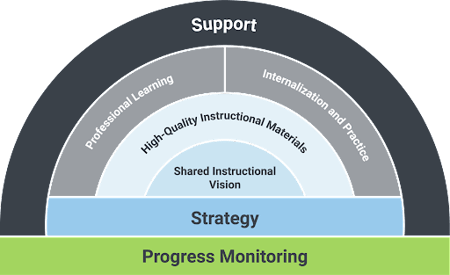As more and more high-quality instructional materials (HQIM) become available, we have noticed a tension with districts across the country between being excited about the opportunities for new, rigorous materials, and the concern about when and how to get started.
While some district-level decisions are guided by state policy and timelines, there are five components that we have found that will help to shape any district’s academic strategy, regardless of where it is during a curriculum adoption window. These components include:

Creating a shared vision for instruction before you are selecting a new curriculum,
-
Selecting High Quality Instructional Materials,
-
Developing a professional learning strategy, and providing opportunities for teachers to internalize and practice with the new materials to support effective implementation, and
-
Implementing a progress monitoring strategy to ensure your approach is aligned to your vision.
Creating a Shared Vision
Many of the most successful districts have one thing in common, they have a clear and shared vision for what strong instruction looks like in their classrooms. Departments, school leaders, and teachers all understand the vision and know how their actions contribute to the district’s vision.
What are key outcomes of a shared instructional vision?
- Alignment of time, resources, and materials
- Articulation of instructional priorities and what is important
- Direction for priorities for professional learning and investments
- Provides schools and teachers with look-fors for other key actions, expectations
- Increased consistency across departments and teams
Selecting HQIM
Part of selecting HQIM is determining both the breadth and depth of adopting a new curriculum. It’s important to consider the grade band(s) you want to focus on, the content area you believe needs the most support, as well as your allotted budget for the adoption of a new curriculum. Having a team who is onboard for adopting a new curriculum is also important. You’ll want to create a go-to team in your district that is in charge of researching, selecting and implementing curriculum. The process can be challenging and time consuming, so consider who is a strong fit. Consider which teachers and school leaders are subject matter experts and who is willing to spend the time digging into evidence-based research for a new curriculum.
After you select your team, it’s time to start researching what curriculum you might adopt for your district. It’s critical to ground your decision in research. One great way to do this is looking on Ed Reports. Ed Reports reviews many curriculums and does the deep dive work to make your decision based on what your district specifically needs and values.
Following this research, consider a small launch to create more content experts across schools. Perhaps you want to have one or two grade levels or high performing teachers start launching the curriculum in the spring or in year 1. Finally, you’ll want to consider how you will measure success. This could look like student performance on assessment or teacher performance during live instruction.
Developing a Professional Learning Strategy
When rolling out new materials, it’s important to provide teachers and leaders with professional learning experiences that are grounded in materials they will be using with students and structured around repeated cycles of inquiry.
According to Practice What You Teach, a 2017 report from the Aspen Institute, “Teachers deserve both materials and professional learning experiences that address the decisions they are making with their students in the context of the actual materials they are using. Providing teachers with generic strategies divorced from their day-to-day reality makes it less likely teachers will apply what they learn to improve practice or student outcomes.” Below are some questions to consider when developing your professional learning strategy:
- What vendor-led opportunities do we need to plan for?
- Many publishers offer full-day institutes for teachers and leaders but you'll want to be mindful of timing as summer dates can book up well in advance!
- Where can your internal professional development team lean in?
- Think about more nuanced PD for teachers - what are those bite-sized sessions you can offer that will support teachers with effective implementation?
- Who internally has the expertise to build and lead sessions?
- How long is your runway?
- How much time between roll out and selection will you have?
- What sessions can be offered before teachers start implementing the curriculum with their students?
Provide Opportunities for Internalization and Practice
Closely aligned to your professional learning strategy is the need to provide opportunities for teachers to internalize the materials they will be using with their students, and the need to have opportunities to practice lesson delivery in a safe space. While professional learning is often a district-level strategy, opportunities for internalization and practice tend to occur at the school level. By providing teachers with a process for engaging with lesson content and materials before engaging in planning for lesson delivery, teachers have an opportunity to practice honing instructional skills in a low-stakes environment and receive feedback that will improve instructional delivery. Whenever possible, we encourage you to leverage existing structures to support lesson internalization. Think: lesson plan templates and guidance, common planning/PLC meetings, department meetings, and informal observations grounded in curriculum-specific feedback.
Monitoring Progress
Finally, after all these things are in place, you’ll want to create a system to monitor progress on curriculum implementation. It’s important to work with the curriculum team to create systems of accountability and ensure progress is being made. What questions can you ask during informal observations that will allow you to get a sense of teacher efficacy with materials? What student outcome data will you be reviewing and at what intervals? You’ll also want to consider any competing priorities that teachers may be facing to execute the curriculum with integrity and how you can mitigate those challenges.
Check out our webinar on the same topic!
.png)




